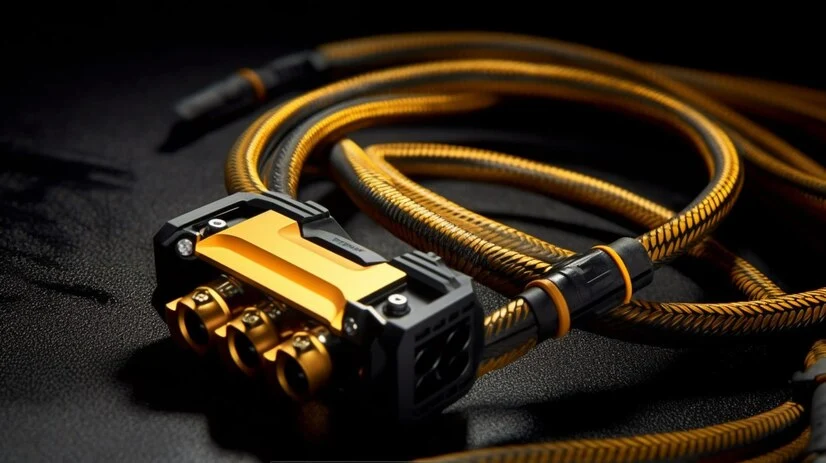In today’s tech-driven world, SATA cables are an essential component in virtually all modern computing systems. Whether you’re a professional building high-performance servers or just upgrading your personal computer, understanding SATA cables is vital. SATA (Serial Advanced Technology Attachment) cables are used to connect storage devices like hard drives, solid-state drives (SSDs), and optical drives to the motherboard, enabling fast data transfers.
In this article, we’ll dive deep into the world of SATA cables, their types, and their uses, offering you a detailed, up-to-date guide on how they function and why they’re crucial to your computer’s performance.
What is a SATA Cable?
SATA stands for Serial ATA (Advanced Technology Attachment), a technology that was introduced in the early 2000s to replace the older Parallel ATA (PATA) standard. SATA cables are designed to transmit data in a serial stream, improving data transfer speeds and efficiency compared to the bulkier PATA cables.
Modern computers almost universally use SATA for connecting internal storage devices, thanks to their ability to handle larger data loads at higher speeds. SATA cables typically consist of seven wires: four ground wires and three data wires. These cables connect storage devices to the motherboard, enabling rapid data transmission.
The Evolution of SATA Cable Technology
SATA cables have gone through several revisions since their introduction:
1.0
- Released in 2003
- Data transfer speed: 1.5 Gbps
- Primarily used in older systems
3.0 Gbps
- Released in 2004
- Data transfer speed: 3.0 Gbps
- Backward compatible with SATA I
- Introduced Native Command Queuing (NCQ), which enhances multitasking in hard drives
6.0 Gbps
- Released in 2009
- Data transfer speed: 6.0 Gbps
- The current standard in most modern systems
- Backward compatible with SATA I and SATA II
- Ideal for SSDs and high-performance systems
Each iteration of SATA has brought faster speeds, improved efficiency, and increased compatibility with newer devices. SATA III remains the go-to standard for most personal computers and servers today.
Types of SATA Cables
When it comes to choosing a SATA cable, it’s important to understand the different types available. Each serves a particular purpose and has distinct features.
Standard SATA Cable
The standard SATA cable is the most commonly used type. It has a seven-pin connector that links storage devices like HDDs or SSDs to the motherboard. They typically come in different lengths to accommodate varying setups.
SATA Power Cable
In addition to the data cable, SATA also uses a power cable, which has 15 pins. This cable supplies power to the storage device from the power supply unit (PSU). Without this connection, the hard drive or SSD will not function.
Slimline SATA Cable
These cables are used in smaller devices, like laptops and ultra-slim PCs. They combine both data and power into a single connector, which reduces the number of cables in compact systems.
eSATA Cable
eSATA (External SATA) cables are designed for connecting external drives. They allow users to enjoy SATA’s high transfer speeds for external storage devices, which is useful for data-heavy tasks like video editing or large file transfers.
SATA Express Cable
SATA Express was introduced to combine SATA with PCI Express (PCIe) technology, offering even faster data transfer speeds. However, it’s not as commonly used as other SATA cables since NVMe (Non-Volatile Memory Express) has become more popular for ultra-fast storage.
How to Choose the Right SATA Cable
Selecting the right SATA cable for your needs depends on several factors:
Data Transfer Speed
For most modern systems, SATA III cables are the best option. They offer the highest speeds at 6 Gbps, making them suitable for SSDs and high-performance systems. Ensure the cable is compatible with both your storage device and motherboard.
Length of the Cable
SATA cables come in various lengths, from short 6-inch cables to longer 24-inch ones. It’s essential to choose the appropriate length based on your system’s layout. Overly long cables can lead to clutter and potential interference, while cables that are too short might not reach the necessary connections.
Connector Type
SATA cables come with straight or angled connectors. Angled connectors are ideal for tight spaces, while straight connectors are easier to work with in open environments. Choosing the right connector can ensure a smoother installation.
Durability
If you’re handling a high-performance build or working in a harsh environment, it’s worth investing in higher-quality SATA cables that offer better shielding and are less prone to wear and tear.
Common SATA Cable Problems and Solutions

Loose Connections
One of the most common issues with SATA cables is loose connections. Over time, cables can become dislodged, causing intermittent data transfer or power issues. Each serves a distinct purpose and possesses unique features.
Cable Damage
SATA cables are relatively fragile compared to other types of cables. If they’re bent too sharply or exposed to rough handling, they may stop working. Always handle cables carefully, and avoid sharp bends or kinks.
Compatibility Issues
Sometimes, older motherboards may not be fully compatible with newer SATA cables, especially SATA III. In such cases, you may need to downgrade to an older version like SATA II or check for firmware updates that could resolve compatibility issues.
The Role of SATA Cables in SSDs and HDDs
SATA cables have a significant role to play in both SSDs (Solid-State Drives) and HDDs (Hard Disk Drives). While HDDs are mechanical and rely on spinning disks to read/write data, SSDs use flash memory to perform the same tasks faster. SATA cables allow these devices to connect to the motherboard, enabling data transfer between the storage device and the rest of the system.
For SSDs
SATA III cables are commonly used with SSDs, but they may bottleneck performance compared to NVMe drives that connect via PCIe. However, for general purposes, SATA III offers a decent balance between cost and performance.
For HDDs
SATA cables remain the standard for traditional hard drives, where the bottleneck is more about the mechanical speed of the drive itself rather than the connection type. Even older SATA II cables work well with slower, bulk storage devices.
Tips for Maintaining Your SATA Cables
To ensure your system runs smoothly, it’s important to maintain your SATA cables and avoid common pitfalls.
Regular Inspections
Make it a habit to check your SATA connections periodically, especially if you frequently open up your PC case. Loose or disconnected cables can cause frustrating issues.
Proper Cable Management
Good cable management not only makes your system look cleaner but also improves airflow, reducing the chance of overheating. Use cable ties or clips to keep SATA cables tidy and out of the way of moving parts like fans.
Replace Faulty Cables
If you experience slow data transfer speeds or your drives aren’t recognized, the SATA cable might be the culprit. Try swapping it with a new one to see if performance improves.
Conclusion
SATA cables may seem like a small component of your computer system, but their importance cannot be overstated. Whether you’re building a new computer, upgrading your storage, or troubleshooting issues, understanding how SATA cables function and how to choose the right one is crucial. With the right cable, you can optimize data transfer speeds, ensure a stable connection, and enhance the overall performance of your storage devices.
By following best practices and choosing high-quality cables, you’ll ensure your system is both reliable and fast. As technology continues to evolve, SATA cables remain a cornerstone of internal data connections, and knowing how to manage them will keep your systems running smoothly for years to come.
